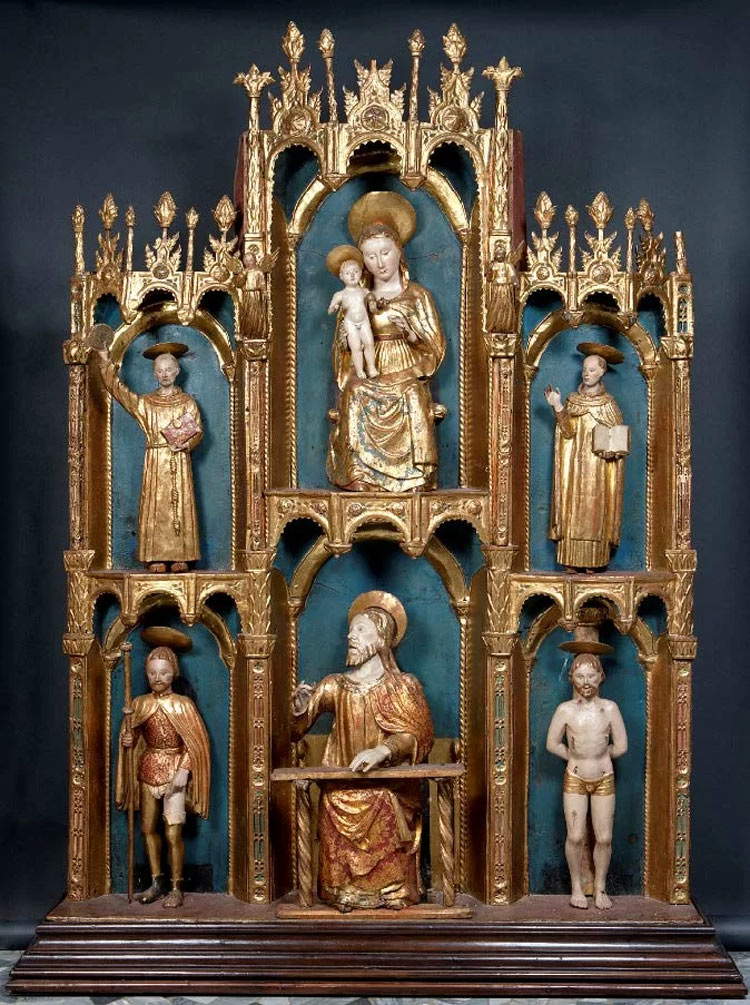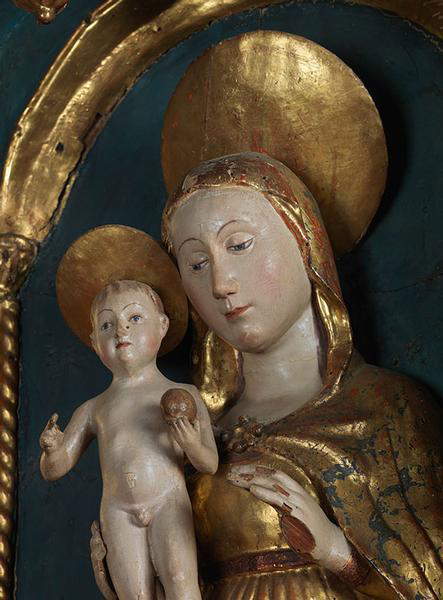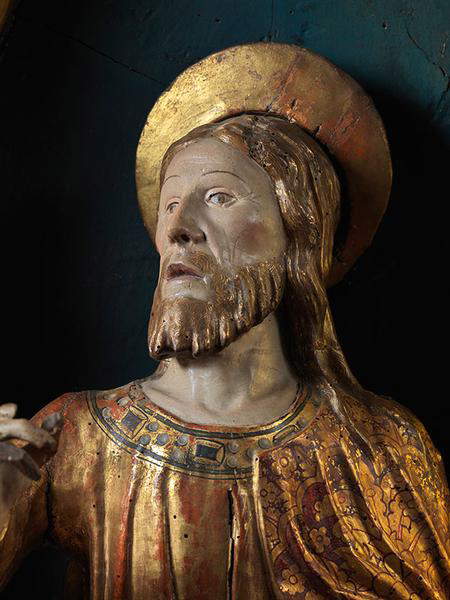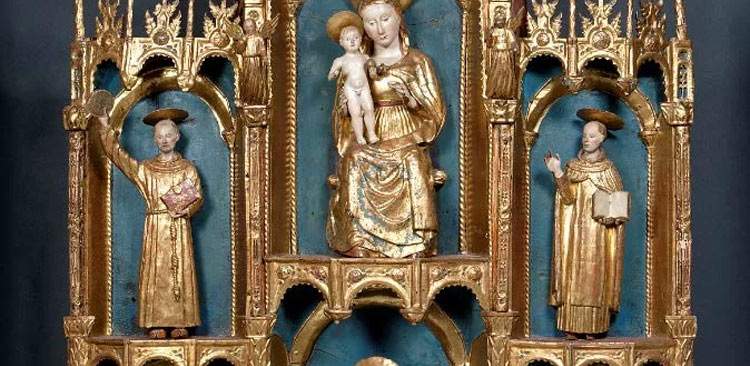The itinerary of the Civic Museum of Castelvecchio in Verona is enriched, and with a work of great value: in fact, an extraordinary wooden Renaissance polyptych, known as the “Polyptych of St. Luke,” a work attributed to a Veronese carver, dating back to a period between the 1570s and 1580s, has been on display in the museum’s halls for a few days. The polyptych was purchased over the summer by the Ministry of Culture and Tourism and has been part of the Castelvecchio itinerary since last Dec. 17: MiBACT allocated it to the Veronese museum as a deposit from the Giorgio Franchetti Gallery at Ca’ d’Oro in Venice.
We do not know the name of the polyptych’s author, but it is likely to be an artist close to the Giolfino workshop and to Giovanni Zebellana (Verona, 1457 - 1504), among the leading woodwork artists in late 15th-century Verona: indeed, the polyptych could be a trait d ’union between the Giolfino and Zebellana’s activities. The author was also affected by the climate of renewal brought to Verona by Andrea Mantegna (Isola di Carturo, 1431 - Mantua, 1506), who between 1457 and 1459 delivered one of his greatest masterpieces, the San Zeno Altarpiece, to the city, effectively initiating the Veronese Renaissance: the architectural layout of the frame and the conception of the statues are considered by art historians to be indicative of this Mantegna influence.
The polyptych consists of two registers with three compartments each: in the center, in the upper register, is the enthroned Madonna and Child flanked by Saint Bernardine of Siena on the left and Saint Vincent Ferrer on the right. Below, in the center is Saint Luke the Evangelist seated at a writing desk with Saint Roch on the right and Saint Sebastian on the left. The figures are enclosed within an elaborate frame (this is still the original frame and is intact), with uprights consisting of openwork pilasters (the openwork is applied on red or blue paper backgrounds, in imitation of enamels, according to a tradition typical of these areas) and foliate columns. The ensemble still retains the polychromy, which reaches highly refined results in the rendering of the flesh tones and the precious details of the ornaments.
 |
| Unknown carver, Polyptych of Saint Luke (c. 1470-1480; polychrome wood; Verona, Museo di Castelvecchio, on deposit from the Franchetti Gallery at Ca’ d’Oro) |
Before arriving in the halls of Castelvecchio, the Polyptych of Saint Luke underwent conservation work. The room that houses it has been rearranged for the occasion (without, however, altering the balance desired by Carlo Scarpa’s historical layout), and will allow to observe the work alongside works by Carlo Crivelli, Francesco Bonsignori, and Mantegna himself, as well as Francesco Benaglio and Domenico Morone, artists who, according to experts, reveal stylistic affinities with the cultural sphere of the anonymous carver who made the wooden polyptych, and in turn demonstrate Mantegna cues.
The polyptych was unveiled last Dec. 17 at the Museo di Castelvecchio, and in attendance were Mayor Federico Sboarina, Culture Councillor Francesca Briani, Civic Museums Director Francesca Rossi, Veneto Regional Museums Director Federica Gonzato, antiquarian Gian Marco Savio, who sold the work to Mibact, and Pierantonio Bellini of the Friends of the Civic Art Museums.
“Since the last Dpcm that imposed the closure of museums,” said the mayor, “an important path of enrichment of the collections of Verona’s Civic Museums has been set in motion, which today, with this Polyptych on permanent display in Castelvecchio, undoubtedly reaches one of its highest moments. I would like to thank the Mibact for the opportunity offered and for the esteem accorded to the Verona Civic Museum system, which was chosen to host this extraordinary work.”
“An important result,” says Councillor Briani, “the result of the managerial foresight of Director Rossi who, this summer, with a formal request to Mibact, made concrete the assignment to the Verona Civic Museums of this stupendous 15th-century work. A masterpiece of inestimable historical and artistic value, now on permanent display in the spaces of the Scaliger Museum. During this closing time, to offer the public a preview of this masterpiece, shots will be taken that will then be made visible on the Museums’ website and social.”
“For Verona’s collections, this is a form of enhancement unprecedented in the history of the Verona Civic Museums,” explains Director Rossi. “A concrete expression of the existing harmony between the Ministry and the Italian Civic Museums, aimed at supporting the development of the National Museum system. The Polyptych is now placed in comparison with paintings by Mantegna, Francesco Bonsignori, Carlo Crivelli and, in particular, in relation to works by Francesco Benaglio and Domenico Morone, which reveal clear stylistic affinities, with the cultural sphere of the carver and show similar figurative references to Mantegna models.”
 |
| Unknown carver, Polyptych of Saint Luke, detail |
 |
| Unknown carver, Polyptych of Saint Luke, detail |
 |
| Unknown carver, Polyptych of Saint Luke, detail |
 |
| The Polyptych of Saint Luke exhibited in Castelvecchio |
 |
| Verona, Castelvecchio Museum gets a new masterpiece: a 15th-century wooden polyptych |
Warning: the translation into English of the original Italian article was created using automatic tools. We undertake to review all articles, but we do not guarantee the total absence of inaccuracies in the translation due to the program. You can find the original by clicking on the ITA button. If you find any mistake,please contact us.